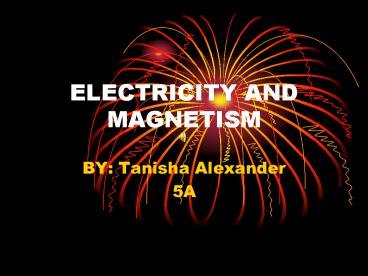ELECTRICITY AND MAGNETISM PowerPoint PPT Presentation
1 / 17
Title: ELECTRICITY AND MAGNETISM
1
ELECTRICITY AND MAGNETISM
- BY Tanisha Alexander
- 5A
2
ELECTRICAL QUANTITIES
3
POWER P AND ENERGY, E OR W
- Energy is the ability of an object to do work,
therefore work is done or things happen whenever
energy transfers take place. - Energy and Work are measured in Joules (J).
- The mathematical equation for work is Work
Force x displacement.
4
EXAMPLES OF SITUATIONS WHERE WORK IS DONE OR
ENERGY IS NEEDED.
- A Shopper pushing a cart down the aisle in a
supermarket. - An athlete throwing a javelin.
- A police officer chasing a thief.
- A mother chasing after her baby
- N.B No work is done when a boy pushes a wall
because there is no displacement in this
situation.
5
BRIEF EXAMPLE AND SOLUTION OF A QUESTION USING
THE MATHEMATICAL FORMULA FOR WORK.
- 1) A 30N force is applied horizontally causing a
block to be displaced horizontally 5m along a
frictionless floor. How much work is done? - SOLUTION
- W F x d cos F x d, since 0
- (30 x 5) Nm 150J
6
DIFFERENT FORMS OF ENERGY.
- Mechanical energy consisting of potential energy
and kinetic energy. - Gravitational potential energy.
- Elastic Potential Energy.
7
PRINCIPLE OF CONSERVATION OF ENERGY.
- The Principle of Conservation of Energy states
that energy can neither be created nor destroyed
but can only be transformed from one form to
another.
8
ENERGY TRANSFORMATIONS
- EXAMPLE
- List four energy transfers that will take place
at an oil burning power station. - SOLUTION
- Chemical energy electrical energy
mechanical energy light and heat energy
9
Electromagnetic radiation the
photovoltaic cell electrical energy
Chemical energy the internal
combustion engine mechanical energy chemical
energy cells and batteries
electrical energy elastic potential energy
a catapult kinetic energy
10
POWER
- Power is work done or energy converted per unit
time. - Power force x displacement/ time taken energy
transformed/ time taken. - Power is measured in watts (W)
- Large amounts of power are measured in kilo
watts (kW) OR megawatts (MW).
11
VOLTAGE
- Voltage measures the work done by a battery or
other sources in driving 1 coulomb of charge
between two points in an electric circuit. - The unit for voltage is the volt.
- The volt is defined as one joule per coulomb.
12
RELATIONSHIP BETWEEN VOLTAGE AND ENERGY
- Energy (E) charge (Q) x voltage (V)
- Energy current x time x
voltage - (joules)(amperes) x (seconds)
(volts) - E Q x V
- Therefore
- Q E/V
- And
- V E/Q
13
RELATIONSHIP BETWEEN VOLTAGE AND POWER.
- Power is the rate of energy transfer or the rate
at which work is done. - P E/t (Q x V)/t (I x t x V)/t IV
- Therefore
- P VI
14
WORKED EXAMPLE TO DEMONSTRATE BOTH RELATIONSHIPS.
- The starting motor of a car draws a current of 60
amperes from a 12 volt battery for 7 seconds.
Calculate a the charge flowing, b the power
dissipated and c the energy transferred. - Solution
- A. charge current (A) x time (s) (60 x 7) As
420C - B. power current x voltage (60 x 12)W 720 W
- C. energy power x time 720 x 7 5040 J
15
THE NEED FOR REDUCING WASTAGE OF ELECTRICAL
ENERGY SOME GUIDELINES THAT CAN HELP.
- There is limited reserves of fossil fuels, hence
there is the need to conserve. - Use fluorescent lamps rather than incandescent
lambs, since less electrical energy is required. - Use solar rather than electrical or gas fired
water heaters to conserve electrical energy. - High efficiency refrigeration and a/c units.
16
QUIZ
- 1) Define energy?
- 2) What is the mathematical equation for work
done? - 3) List the three main types of energy.
- 4) State the Principle of Conservation of Energy.
- 5) Define power, voltage and the volt.
- 6) List the energy transfers that will take place
at a hydroelectric plant. - 7) A 20N force is applied horizontally causing a
block to be displaced horizontally 6m along a
frictionless floor. How much work is done?
17
THANK YOU FOR VIEWING

